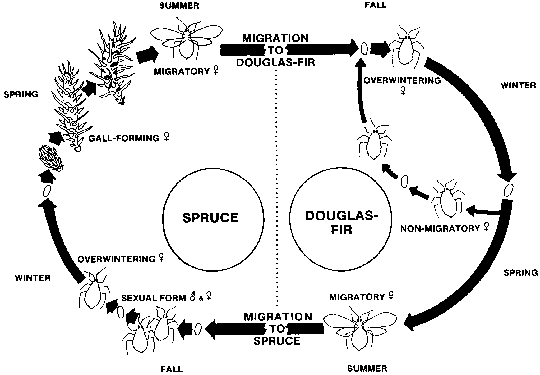Knowledgebase
Cooley Spruce Gall #619561
Asked March 29, 2020, 1:56 PM EDT
Thanks
Eaton County Michigan
Expert Response
In the above article, reference is made to apply an insecticide on the nymphs before they develop a waxy coating. Insecticidal soap is mentioned more than once in several other articles and is approved for home use. Timing is everything and MSU can help you with that.
Refer to the MSU page called: Enviroweather msu.edu
You will see a map of the state. Click on a MSU research station that is near to you.
Up at the top of the page.. choose trees. Under trees choose Christmas trees.
The Cooley gall adelgid will appear on the left. When you click on that you will see
specific information of when to apply your insectcide. The date is determined by the amount of days we have had at a certain temperature(in this case 50). Researchers have determined growth stages of an insect depending on how many days of 50 degrees or more we have had. Temperature, of course, determines development.
When I looked at the chart Grand Rapids is at 15 degree days and the spraying can commence beginning at 25.
Obtain your spray and watch the enviroweather web site for the right time window.
The Penn State article refers to different degree days. Disregard those numbers. There are several ways to count the degree days. They are using a different measure.
Thanks
Here are some control suggestions from Colorado State. Horticultural oils and insectidical soaps have the least environmental impact on beneficial insects so that is probably why they are suggested first. Note that infestations are cyclical and also that the discoloration of needles is only temporary according to this article. If you have trouble reading the information the site is:
extension.colostate.edu Cooley Spruce Galls-5.534
Control
Control of Cooley spruce gall is rarely needed to protect tree health. Infestations of this insect are highly cyclical, with their numbers often changing greatly from season to season. However, insects may be controlled to prevent aesthetic injuries that can detract from tree appearance.
Control must occur before galls begin to form. Apply treatments in fall, after the overwintering females have settled on the plants, or, most commonly, in spring. Spring applications are most effective if made before the insects have begun to swell with eggs, which typically occurs in late April.
Foliar treatments of carbaryl (Sevin) and permethrin have been most effective in Colorado State University trials. Horticultural oils have also been very effective can cause temporary discoloration of spruce needles. See fact sheet 5.569, Insect Control: Horticultural Oils. Insecticidal soaps are only moderately effective on spruce, but are used widely to control this insect on Douglas-fir. Direct all foliar applications at the underside of spruce terminals where the overwintering aphids are concentrated.
Soil injections of imidacloprid can control Cooley spruce gall adelgids. However, the treatments often fail to kill many of the insects until after the galls are formed. These galls usually remain green rather than browning in early summer. Fall applications are recommended for this insect.
Removal of old galls will not affect infestations because the insects have left the tree by the time galls turn brown and become conspicuous. Old galls are not later used by any stages of this insect.
When establishing plantings, avoid placing Douglas-fir and spruce close together.

Figure 4: Life cycle of the Cooley spruce gall adelgid. Research indicates that the adelgids leaving spruce must develop on Douglas-fir before returning to spruce. Observations in Colorado suggest that spruce to spruce movement also may occur.
Table 1: insecticides for control of Cooley spruce gall adelgids.
- carbaryl (Sevin)
- horticultural oils
- imidacloprid (Merit, etc.)
- insecticidal soaps
- permethrin (Bug Stop, Astro, etc.)
Always read and follow mixing and usage instructions on the label. Direct applications against the overwintering insect, preferably before egg production has begun. Treatments usually are best made during warm periods in fall (mid-October or November) or in late March through April.
* Colorado State University Extension entomologist and professor, bioagricultural sciences and pest management. 11/98. Revised 6/13.
Colorado State University, U.S. Department of Agriculture, and Colorado counties cooperating. CSU Extension programs are available to all without discrimination. No endorsement of products mentioned is intended nor is criticism implied of products not mentioned.
Go to top of this page.
Give to CSU Extension
Search the Site
Recent Extension Posts
- Practical Feeding Methods for Small Poultry Flocks
- Raising Poultry the Organic Way
- Ailments of Turkeys and Other Fowl
- Managing Cattle Impacts When Grazing on Wet Soils
- Conenose Bugs (“Kissing Bugs”) and Insects of Similar Appearance in Colorado
- Brown Soft Scale – A Common Insect Pest of Indoor Plants
- Grape Leafhopper (Erythroneura spp.)
- Purchasing Rural Property in Colorado


